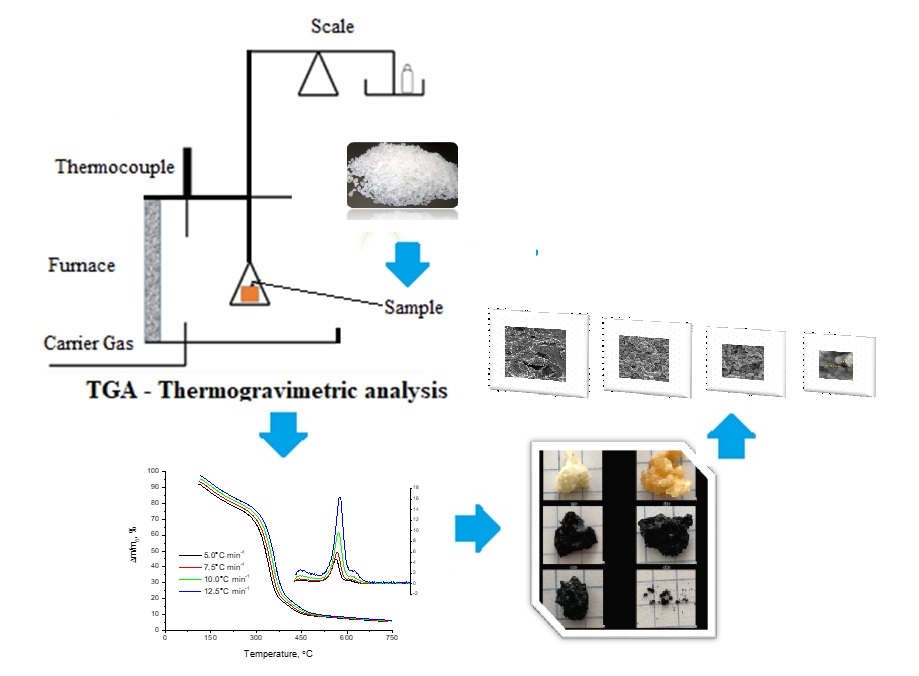Effect of Heat Treatment on the Supramolecular Structure of Copolymers Based on Poly(propylene glycol fumarate phthalate) with Acrylic Acid
DOI:
https://doi.org/10.31489/2959-0663/2-24-9Keywords:
acrylic acid, polypropylene glycol fumarate phthalate, polymer, micrographs, morphology, electron microscope, thermogravimetric analysis, supramolecular structureAbstract
Previous studies investigating the thermal decomposition of p-PGFPh:AA copolymers in an inert atmosphere have provided only a general understanding of the changes that occur during thermolysis. Comprehensive studies are required to gain a better understanding of these processes [1]. The most comprehensive information on the influence of various factors on both the kinetics and the supramolecular structure of the resulting products can be obtained by combining the method of thermal analysis with IR, mass spectrometry, and scanning electron microscopy. The compounds studied have two different compositions, namely p‑PGFPh:AA 6.77:93.23 mol % and p-PGFPh:AA 86.67:13.33 mol %. These compounds were then subjected to a thermolysis process, which resulted in the emission of gases and a decrease in sample weight. The degradation process can be divided into three stages: 1) Depolymerization of the main chain; 2) Depolymerization of the side chain; 3) Final decomposition. These processes occur sequentially at different temperature ranges. According to TG- and DTG studies, complete decomposition of p-PGFPh:AA copolymers occurred at Tterm = 340–350 °C. In this temperature range, a slight loss of sample mass (less than 10 wt %) was observed along with a slight gas evolution. The main gaseous products from the transformation of the studied samples were CO and CO2. This was supported by IR-CO (2000–2200 cm−1) and CO2 (2310–2370 cm−1) as well as mass spectrometric observations. The final products resulting from the thermolysis of p-PGFPh:AA copolymers were examined under an electron microscope. The results showed a similar morphological pattern of mesostructures with sizes ranging from 0.3–1.5 μm, which were observed depending on the porous structure of the initial polymer material. Based on the experimental data, it can be concluded that the p-PGFPh:AA copolymers (in proportions of 6.77:93.23 mol % and 86.67:13.33 mol %) have a relatively high degree of resistance to heating and do not undergo any changes in chemical composition, particle size and shape. In conclusion, the results clearly indicate that the selection of conditions for pyrolysis plays a crucial role in increasing the thermal stability of polymeric materials. This method allows for purposeful changes in the structure and properties of polymers.

Downloads
Published
How to Cite
Issue
Section
License
Copyright (c) 2024 Akmaral Zh. Sarsenbekova, Abylaikhan N. Bolatbay, David Havlicek, Zhannur A. Issina, Assiya Zh. Sarsenbek, Nurgul A. Kabdenova, Muslim A. Kilybay

This work is licensed under a Creative Commons Attribution-NonCommercial-NoDerivatives 4.0 International License.
This work is licensed under a Creative Commons Attribution-NonCommercial-NoDerivatives 4.0 International License.
Authors retain copyright and grant the journal right of first publication with the work simultaneously licensed under a Creative Commons Attribution License (CC BY-NC-ND 4.0) that allows others to share the work with an acknowledgement of the work's authorship and initial publication in this journal.



